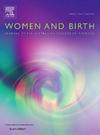Keeping birth at home: Community and service provider visions for perinatal wellness and continued Inuit childbirth in Nunavik
IF 4.4
2区 医学
Q1 NURSING
引用次数: 0
Abstract
Problem
Childbirth on traditional territories is unattainable for many Indigenous peoples living in remote communities in Canada.
Background
In Nunavik, Inuit territory in northern Quebec, rapid population growth risks exceeding local midwifery capacity. This poses challenges to community-based childbirth in a region recognized for reclaiming Inuit midwifery and local birthing.
Aim
To explore community views on protective factors of maternal and family perinatal wellness and continued local birthing.
Methods
In ten communities, Inuit families and perinatal service providers created a total of 54 fuzzy cognitive maps on protective factors for (1) birth in a good way in Nunavik, (2) maternal and family perinatal wellness, and (3) community-based birthing in Nunavik. We used fuzzy transitive closure to examine direct and indirect connections and collated individual factors into categories using inductive thematic analysis.
Findings
Well-equipped local medical facilities and services, community birthing centres run by Inuit midwives, and Inuit perinatal traditions had the strongest influence on experiencing birth in a good way in Nunavik. Inuit youth perspectives featured instrumental and emotional support for mothers and families, along with health and self-care in pregnancy as the most influential factors on maternal and family perinatal wellness. Prominent protective factors for community birth in Nunavik included maternal-infant health and wellness, local Inuit midwifery services, and well-resourced medical facilities.
Discussion
Fuzzy cognitive mapping was helpful in informing community visioning of local childbirth and maternal and family perinatal wellness in Nunavik.
Conclusion
Inuit-led midwifery services are essential to continued local childbirth in the region.
保持在家分娩:社区和服务提供者对努纳维克围产期健康和因努伊特人继续生育的愿景。
问题:对于生活在加拿大偏远社区的许多原住民来说,在传统领地分娩是遥不可及的:背景:在魁北克北部的因纽特人领地努纳维克(Nunavik),人口的快速增长有可能超过当地的助产能力。目的:探讨社区对孕产妇和家庭围产期健康保护因素以及继续在当地分娩的看法:在 10 个社区中,因纽特人家庭和围产期服务提供者共绘制了 54 幅模糊认知地图,内容涉及:(1)努纳维克良好分娩方式的保护因素;(2)孕产妇和家庭围产期健康;(3)努纳维克社区分娩。我们使用模糊传递封闭法来检查直接和间接联系,并使用归纳主题分析法将各个因素归类:设备齐全的当地医疗设施和服务、因努伊特助产士运营的社区分娩中心以及因努伊特围产期传统对在努纳维克体验良好的分娩方式影响最大。从因纽特人青年的角度来看,对母亲和家庭的工具和情感支持,以及孕期健康和自我保健是对母亲和家庭围产期健康影响最大的因素。努纳维克社区分娩的主要保护因素包括母婴健康和福祉、当地因努伊特助产服务以及资源充足的医疗设施:讨论:模糊认知绘图有助于为努纳维克社区的本地分娩以及孕产妇和家庭围产期健康的愿景提供信息:因纽特人主导的助产服务对该地区继续开展本地分娩至关重要。
本文章由计算机程序翻译,如有差异,请以英文原文为准。
求助全文
约1分钟内获得全文
求助全文
来源期刊

Women and Birth
NURSING-OBSTETRICS & GYNECOLOGY
CiteScore
7.20
自引率
13.20%
发文量
371
审稿时长
27 days
期刊介绍:
Women and Birth is the official journal of the Australian College of Midwives (ACM). It is a midwifery journal that publishes on all matters that affect women and birth, from pre-conceptual counselling, through pregnancy, birth, and the first six weeks postnatal. All papers accepted will draw from and contribute to the relevant contemporary research, policy and/or theoretical literature. We seek research papers, quality assurances papers (with ethical approval) discussion papers, clinical practice papers, case studies and original literature reviews.
Our women-centred focus is inclusive of the family, fetus and newborn, both well and sick, and covers both healthy and complex pregnancies and births. The journal seeks papers that take a woman-centred focus on maternity services, epidemiology, primary health care, reproductive psycho/physiology, midwifery practice, theory, research, education, management and leadership. We also seek relevant papers on maternal mental health and neonatal well-being, natural and complementary therapies, local, national and international policy, management, politics, economics and societal and cultural issues as they affect childbearing women and their families. Topics may include, where appropriate, neonatal care, child and family health, women’s health, related to pregnancy, birth and the postpartum, including lactation. Interprofessional papers relevant to midwifery are welcome. Articles are double blind peer-reviewed, primarily by experts in the field of the submitted work.
 求助内容:
求助内容: 应助结果提醒方式:
应助结果提醒方式:


